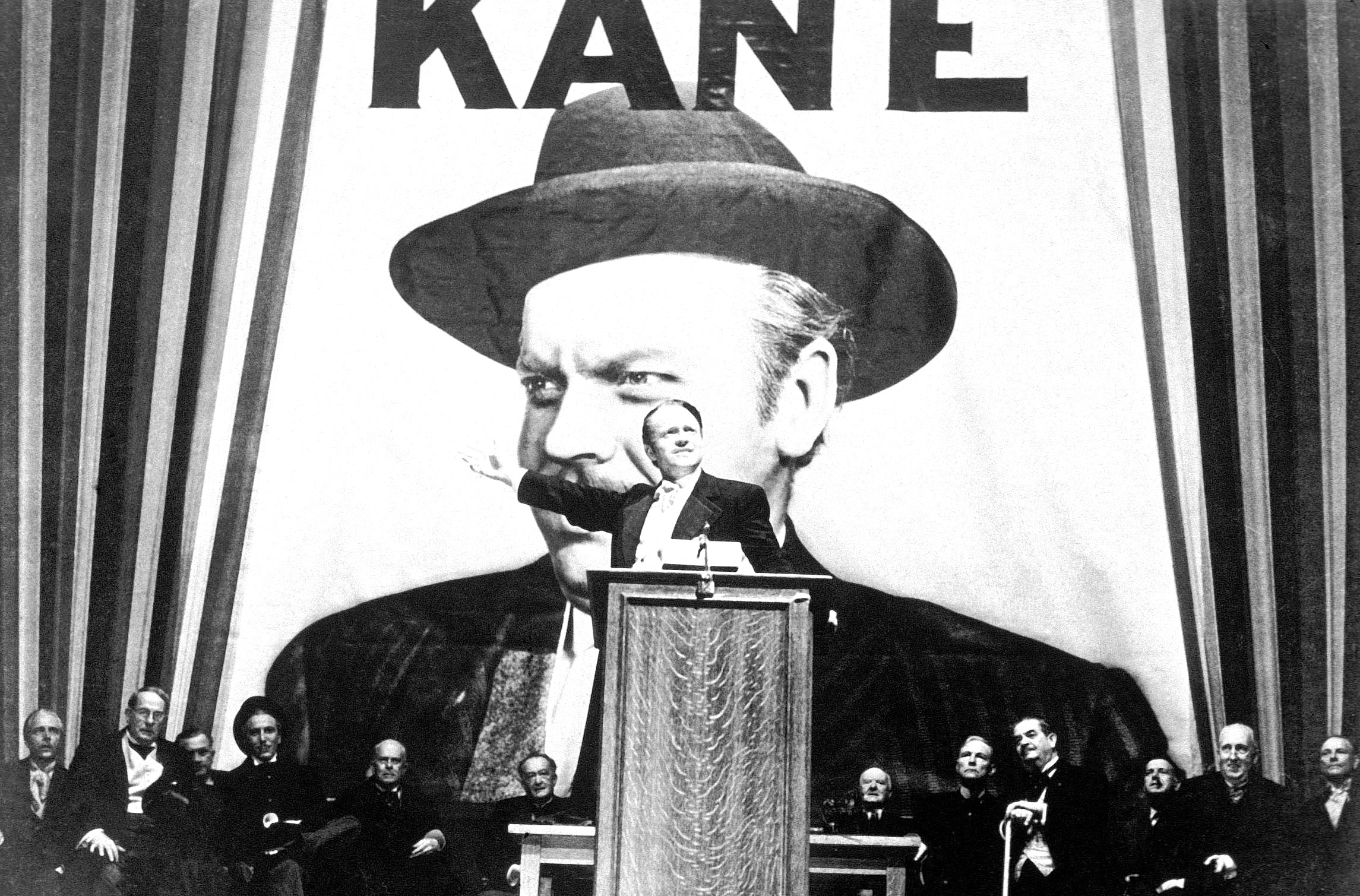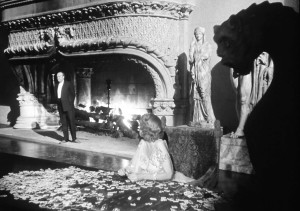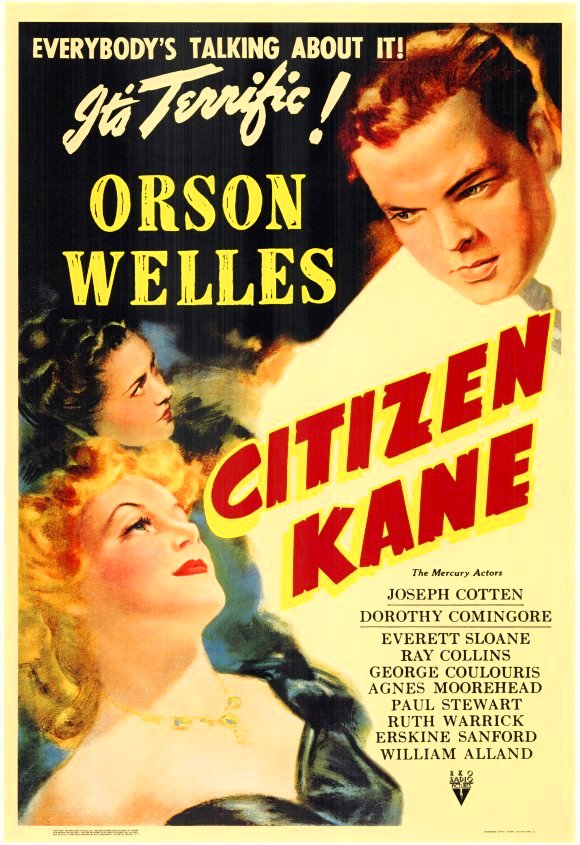
“Rosebud.” – Charles Foster Kane
One of the ten best films ever made. Orson Welles’ Citizen Kane (1941) has been hailed so long as such a landmark in technical filmmaking that it has overshadowed the fact that it contains one of life’s most profound messages. Charles Foster Kane (Welles) is raised into exorbitant wealth, idealistically runs the New York Inquirer newspaper and sensationalizes the news, becomes an economic baron in every way, idealistically runs for New York State Governor, and acquires so many things that the bulk of them lose all meaning. Kane begins young adulthood as a boisterous whippersnapper, and then proves it is possible in this world to buy unhappiness.
Indeed, “Kane” is known for its technical breakthroughs: Deep focus, optical illusions, low-angle shots, non-linear narrative, baroque music techniques, the “documentary” newsreel as story overview (it becomes a “normal” movie after it completes), the breakfast scene montage which depicts Kane’s entire first sour marriage in five vignettes, the matte shots – all innovative techniques that have molded modern film language to this day. The whole film is flashback, as told through interviews of people that knew Kane, as told to journalist Mr. Thompson (William Alland) on an investigative tour. The criterion objective is to figure out the meaning to Kane’s last word, “Rosebud,” or at least find insightful information into any future Kane biography.
“To forty-four million U.S. news buyers, more newsworthy than the names in his own headlines, was Kane himself, greatest newspaper tycoon of this or any other generation,” says a title card in the newsreel sequence. Kane was only a fictional character, albeit, inspired by the real life tycoon William Randolph Hearst, who attempted to buy and bury this film permanently. Hearst did not acquire the rights to bury the film, although he did succeed in stifling the film from reaching a major mass release. The big city markets showed “Kane,” but it wasn’t until a decade later when serious magazines began discussing “Kane” as the It movie of the sound era.
The saddest of the early scenes of “Kane” has dramatic heft. Kane is a child that belongs to poor parents who own a boarding school. It is Walter Parks Thatcher (George Coulouris) who buys-adopts young Charles so he can have a better life. Mary (Agnes Moorehead), the mother, feels this will be of this boy’s best interests. Charles will be heir to Thatcher’s unfathomable riches, but he will lose his origins. But running a newspaper “will be fun.”
 The most important shot of the film however never gets discussed, for all the articles that have ever been written about “Kane” this is a never. At the 8 minute 42 second mark, Kane is on a balcony in the company of Adolph Hitler in the “newsreel footage,” and if there any evocation of Kane’s lost youth and idealism, it’s that brief single shot that wraps up everything spoiled and jaded about Kane. Consider though the context of when the film was made. If Welles had made the film perhaps a year later, I can imagine the entire shot being lifted by studio mandate. Sure, he denounces Hitler in a brief blurb later, but the scene is of Kane blindly supporting Hitler. Powerful men blindly party with other powerful men, never mind their doctrine. As far as I know, there is no Welles quote that exists on how he boldly came up with this balcony shot.
The most important shot of the film however never gets discussed, for all the articles that have ever been written about “Kane” this is a never. At the 8 minute 42 second mark, Kane is on a balcony in the company of Adolph Hitler in the “newsreel footage,” and if there any evocation of Kane’s lost youth and idealism, it’s that brief single shot that wraps up everything spoiled and jaded about Kane. Consider though the context of when the film was made. If Welles had made the film perhaps a year later, I can imagine the entire shot being lifted by studio mandate. Sure, he denounces Hitler in a brief blurb later, but the scene is of Kane blindly supporting Hitler. Powerful men blindly party with other powerful men, never mind their doctrine. As far as I know, there is no Welles quote that exists on how he boldly came up with this balcony shot.
The one mandate that was enforced on “Kane” was the brothel scene that was in Welles’ original screenplay. After Kane has hired the staff of his competitor The Chronicle, he takes them to a brothel. It wasn’t the studio but the Production Code, actually, that required it excised. Welles changed it to a rowdy party scene with dancing girls in glittery outfits, and drunkards cheering on. As a consolation, we get both of these type of scenes in Martin Scorsese’s taboo-breaking “The Wolf of Wall Street” from last Christmas. Joseph Cotton, important as Kane’s chum and arts columnist Jedediah Leland, is the first to groan about Kane’s conversion into a bighead.
Kane blows his first marriage by entering a scandalous relationship with an uneducated floozy named Susan Alexander (Dorothy Comingore) that will ruin his political run for office. But the worst bighead thing he does after they marry is push Susan to become an Opera Star, despite everybody’s urging that she stinks. Leland trashes Susan in a review at their own newspaper, and thus, a friendship is over. Lots of friendships end due to Kane’s overinflated ego.
 If I were to sum up the meaning of Kane’s tragic trajectory, it’s the endless buying of antiques and showpieces. A scene where Susan, retired from opera, is doing jigsaw puzzles, has Kane pacing in the background where the size of his fireplace looks like it’s going to swallow him up. Nobody in the world, no matter how rich they are, needs a fireplace this ostentatious. It’s not the end of Kane’s purchasing of gaudy furnishings, but it is the best symbol of it. Susan has already been driven to a suicide attempt, and at the end chooses to abscond from financial support just to get away from Kane and his monstrous mansion of Xanadu.
If I were to sum up the meaning of Kane’s tragic trajectory, it’s the endless buying of antiques and showpieces. A scene where Susan, retired from opera, is doing jigsaw puzzles, has Kane pacing in the background where the size of his fireplace looks like it’s going to swallow him up. Nobody in the world, no matter how rich they are, needs a fireplace this ostentatious. It’s not the end of Kane’s purchasing of gaudy furnishings, but it is the best symbol of it. Susan has already been driven to a suicide attempt, and at the end chooses to abscond from financial support just to get away from Kane and his monstrous mansion of Xanadu.
And, of course, there is the meaning at the end as to the reveal of “Rosebud.” The explanation means everything, and nothing, depending on how you look at it.
Welles, who came from the Mercury Theater and from his radio serial “War of the Worlds,” wrote and directed it at age 25. Yes, that’s an extraordinary embodiment of Welles playing Kane throughout his adult ages, but he’s gained by first-rate old age makeup. To this day, “Kane” is the benchmark in film reverence, and it’s still the best film ever by a first-time director. Extraordinary, indeed. My second favorite Welles film is the suspense-thriller “The Lady from Shanghai” (1948) which was ahead-of-its-time weird, a twisted noir with a heap of avante-garde visual images.
“Citizen Kane” though is as essential as they come. But, like for me, it’s not a film like you’ve heard that will give you instant gratification the night you first see it. Let it grow on you for six months. Its’ richness and fullness, deepens upon the more you reflect on it. “Rosebud” will deepen in meaning, too, as you take the time to ponder.
119 Minutes. Rated PG.
DRAMA / CHARACTER STUDY / MASTERPIECE VIEWING
Film Cousins: “Wall Street” (1987); “Born Rich” (2003); “Arbitrage” (2012); “The Wolf of Wall Street” (2013).





